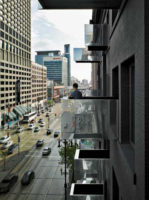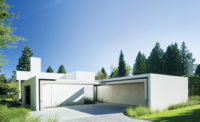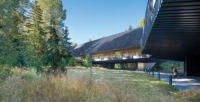The Winnipeg neighborhood known as Osborne Village boasts a marvelous elixir of mixed demographics, indie businesses, hipster “speakeasies,” walkability, and that elusive attribute that can be described as an edgy vibe. All of this compelled the Canadian Institute of Planners to dub it “Canada’s Greatest Neighbourhood” in 2012. The irony of enclaves like these, though, is that they attract homogeneous new developments that threaten to snuff out the charm that made them desirable in the first place—over the past few years, a smattering of suburban-looking shoebox buildings have crept into this zone of artists’ studios and tattoo parlors. But with the new OZ condominium project, the local firm 5468796 offers an alternative response.
On the corner of River Avenue—the area’s main thoroughfare—and a quieter side street, OZ enriches the densely textured urban fabric with its distinctive, asymmetrically fenestrated form and outdoor spaces carved out of the building’s mass. Named for both the utopian land in the century-old children’s novel as well as its own neighborhood, it is a building that aspires to link its residents to street life and each other.
“With our work, there’s always this social agenda to create buildings that are not purely inward looking,” says 5468796’s lead architect Sasa Radulovic. “We tried to do this through ‘erosion’—by biting away at the black box with white space, connecting balconies and patios through the building.” The team further broke up the massing by creating what are essentially two discrete boxes, linked artfully by a multi-height glazed transition that serves as the building’s main entrance. The material palette is emphatically modern: white cement board and corrugated black metal cladding, aluminum window framing, and perforated metal screening over the smaller windows. OZ offers a sleek counterpoint to the texture of clapboard and brick elsewhere on the street, yet honors the liberated spirit of the community.
Led by Radulovic in collaboration with coprincipals Johanna Hurme and Colin Neufeld, the project marks a new level of sophistication for this young firm, whose unusual name is taken from its business incorporation number. Its earlier residential projects, like The Avenue on Portage and Stradbrook Avenue apartments, have been more notable for street-front animation than for spatial imagination. Their recent Block_10, a three-story, 10-unit condo building composed of linked elements, can be read as a pilot project for OZ. But now the design team has ramped up both volumetric complexity and scale.
The project began with a design brief to transform three standard house lots into a 25-unit condominium building. Two previous architectural firms had already tried and failed, finding the task impossible within the existing building-height and floor-space restrictions. The 5468796 team rose to the challenge by designing most of the condos as bi-level interlocking units with lofts, so that they fit together within the mass like Tetris blocks. The architects finessed a reduction in the floor-to-floor height requirement from 12 feet to 10 feet for the single-level units. Compensating for the compression created by the lofts, they incorporated 16-foot living spaces into the bi-level units, most of which have two bedrooms. In this way, the design team was able to create a total of seven levels—including mezzanine levels—within the prescribed 60-foot height limit. (Or close, anyway: they negotiated an extra 2 feet of height in order to realize their design.)
The architects created yet more living area with the patios and balconies. Most of the outdoor space is configured in a way that allows residents the option of some privacy, but more often it is open, clearly intended to activate neighborly interaction. (On a rainy end-of-summer afternoon, residents sat on their patio, sheltered from the drizzle above while still able to exchange pleasantries with passersby on the street below.) It’s a European approach, imported by Radulovic (who emigrated from the former Yugoslavia) and Hurme (from Finland). The openness seems natural to them, but North American sensibilities are not quite there yet—hence two of the project’s shared interior patio spaces, cut through the building like the hole in a doughnut, now read as dark caves since the two adjacent condo owners segregated their common space with a solid wall. The architects only shrug. “I’m flabbergasted by the way we treat space here,” says Radulovic. “There’s so much fear of rubbing shoulders with your neighbor.”
People often end up living in formulaic boxes because both residential builders and buyers are afraid of what they don’t know, suggests Radulovic. “We’ve always been interested in breaking out of that. The question is, how do you do it on a budget? I think we’re proving now that you can, on a growing scale.”
PeopleOwner: Undisclosed
Architect: 5468796 Architecture
Consultant(s): Landscape: Plain Projects, Liz Wreford, Principal Landscape Architect
General contractor: Westland Construction Ltd.
Photographer(s): James Brittian Photography (exterior) |
ProductsStructural system cast in place concrete, pre-fabricated hollowcore slabs with white aggregate concrete topping, steel frame, structural steel studs
Exterior cladding White Hardie-Board Fibre Cement Board, Black Corrugated Metal
Roofing Torch down, 2 ply bituminous membrane
Windows Durabuilt Windows, 920 Series
Glazing Alumicor Curtain Wall
Hardware Locksets: Taymor, Schlage Closers: Taymor Exit devices: Von Duprin Pulls: Taymor
Interior finishes Kitchen: Custom Millwork by Aries Woodcraft Ltd. Solid surfacing: Natural stone countertops Special surfacing: High gloss epoxy white concrete finish throughout all suites. Carpet: Interface Flor Special interior finishes unique to this project: All furniture for the display suite shown in the interior photographs provided by hutK, 5468796 custom-designed interior staircase fabricated by Klartech Inc.
Furnishings Chairs: Blu Dot PARAMOUNT right-hand Sectional (fabric: Ceramic Blue), Bensen PARK chair and Ottoman, Muuto VISU sled base chair (2 white + 2 grey), Modernica LOW ROD ARMSHELL (white fibreglass) Tables: Mutto 70/70 Table (grey), Blu Dot SCAMP medium table (white/white on oak), Blu Dot PI side table (walnut)
Lighting Downlights: Maxilite (dining room fixture) Task lighting: Blu Dot PERIMETER floor lamp (yellow/grey), 5468796 custom design island downlighting fabricated by Klartech Exterior: Progress Lighting, RAB design
Conveyance Elevators/Escalators: Kone Ecospace |












Post a comment to this article
Report Abusive Comment